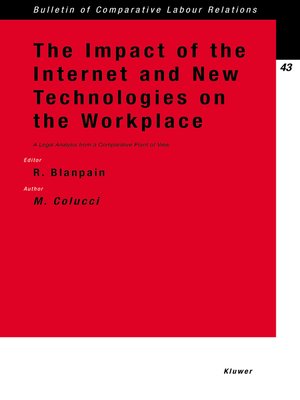The Impact of the Internet and New Technologies on the Workplace
ebook ∣ A Legal Analysis from a Comparative Point of View · Bulletin of Comparative Labour Relations Series Set
By Roger Blanpain

Sign up to save your library
With an OverDrive account, you can save your favorite libraries for at-a-glance information about availability. Find out more about OverDrive accounts.
Find this title in Libby, the library reading app by OverDrive.



Search for a digital library with this title
Title found at these libraries:
| Loading... |
The regulatory architecture available for cyberspace law still seems incapable of conceiving, much less resolving, the new issues of privacy raised by the use of the Internet in the workplace. This penetrating analysis of the thorny problems in this area of the law goes a long way towards clarifying the nature of the conflicts and disputes that arise and that are likely to continue to arise. It is also the first detailed comparative treatment of the subject, analysing the relevant law both at the international level and in six major national jurisdictions.
The author first examines the international jurisdictional problems related to the Internet and new technologies. Starting from an economic analysis of the law of cyberspace, the author demonstrates that the problem of conflicting legal rules may be solved by adopting new laws, regulations and guidelines governing the Internet.
The second part explores the ways in which the Internet and the introduction of new information technologies has dramatically affected the world of work and individual rights. The author analyses the origins, limits and boundaries of these rights, and makes a comparative analysis of the relevant constitutions and statutes in both common law and civil law.
Finally, an examination of the legal systems of the USA, the UK, France, Germany, Italy, and Japan, and of their responses to the new Internet-related issues, enable the author to propose effective ways to achieve a better balance between the employee's right to privacy and the responsibilities of the employer in the new electronic environment.
More than an academic analysis, The Impact of the Internet and New Technologies on the Workplace will provide invaluable guidance to practitioners and policymakers in this burgeoning area of the law. The author's deep understanding of the issues gives his book an immediate relevance that will last for years to come.






